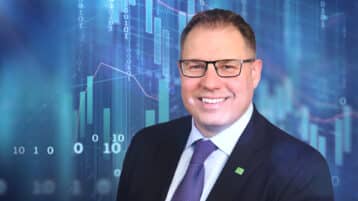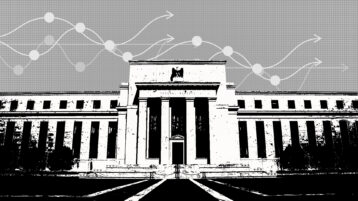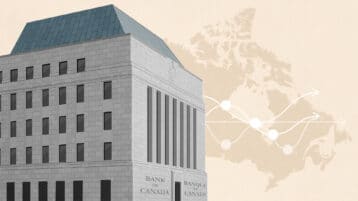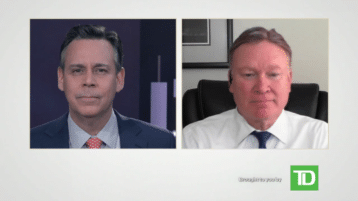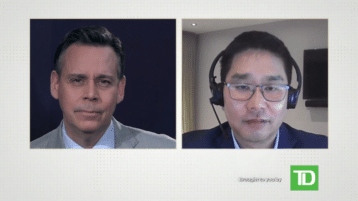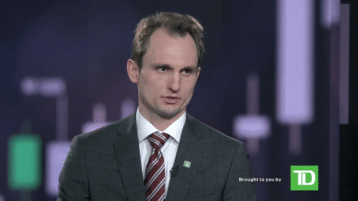Greg Bonnell speaks with Brad Simpson, Chief Wealth Strategist, TD Wealth about his outlook for the markets.
Print Transcript
[music] >> Hello I'm Greg Bonnell and welcome to MoneyTalk Live, brought to you by TD Direct Investing.
Every day will be joined by guests from across TD, many of whom you'll only see here.
We will take you through its moving the markets and answer your questions about investing.
coming up on today show, a little volatility in the markets right now, a lot going on with Brad Simpson, Chief Wealth Strategist it to talk market strategy.
our Anthony Okolie is taking a look at global growth with investors as well. And in today's WebBroker education segment, Caitlin Cormier will show us how to set stock alerts on the WebBroker platform to do the work for you. She joined us a little bit later. Here's how you can get intentions. As always, email moneytalklive@td.com with your questions and your comments. Or you can fill it that your response box under the video player here in WebBroker.
Before we get to all that let's get you an update on the markets.
Of course the Fed minutes this afternoon with a lot of questions about how much further the Fed will go or needs to go to tame inflation. Ahead of that, a bit of a caution, will start here at home with the TSX Composite Index, still in the thick of earnings season especially here in Canada winding down a bit south of the border.
The TSX at this moment, I do believe we are not showing anything all that dramatic.
the NASDAQ basically flat ahead of the Fed.
Trying to make sense out of what we will get from those minutes and where the Fed might be embarked upon a Netzer market update.
Of course we had a strong start to the year in the markets. But it is being tested lately. A lot of economic uncertainty and a lot of questions about exactly where the US Federal Reserve may be headed with rate policy.
Putting a lot into the mix for us as investors. Joining us now is Brad Simpson, Chief Wealth Strategist with TD Wealth to sift through it all. I feel like a shift in narratives at least from some market observers that changes almost on a weekly basis. How do you view all this?
>> First of all thanks for having me.
How to frame all of this?
I think if we kind of stepped back, I think the big surprise so far for this year, you know, I think a fixed income market it's good and I don't think that's much of a surprise.
I'm sure we can cut a dig in there.
Markets started to rally in October and at the time, that probably made some sense to have a little bit but when we start breaking down what the equity market has looked like, really going through January and the kind of component parts of the drivers behind it, that's, I would say if there's that way of framing this or a surprise moment?
I think you have to kind of stepped back a little bit, take a look at what's been moving the market.
What's driving it.
And I think that when I look at it in those terms, it kind of starts to paint a different picture.
>> I think we can actually show the audience a picture you can speak to in terms of what kind of picture we are painting.
>> One of the things it is been so incredible about this year so far is that, what we are showing here is if you took the absolute best performing stocks of 2022 and let's say the best performing were good quality, price well, greater growth, really we started to move into an equity market where fundamentals really came back to the floor. On the opposite side, what really did terribly, if you are to really leverage, you had earnings sometime way, way down the road. More of your fantasy stocks if you will.
Those really, really got hammered in 2022.
The sum down between 50 and 70%.
You look at January and look at where a lot of those were kind of the worst lines.
The worst performing stocks of 2022.
They have been amongst the best around 15% today. That really tells you a story an awful lot of what this market looks like.
Then you start to ask yourself: "well how does this happen?
" Right?
And for me, a little bit is there is this new narrative that is began.
I think also markets, fixed income markets… I think they have been trading on fact.
Late stage. You think interest rates will start moving downwards and six months out, nine months… Things will start to slow.
Equity markets, I think, started to trade on fiction.
I think this fiction was this idea that "okay, are we gonna have a hard landing?
Maybe a soft landing?" And then as the market kept moving that new narrative said "how about no landing".
[laughing]… For us I think you have to say "this is the driver in this is a lot of speculation. A lot of short covering. You know?
And I think the last part is, it's something you and I've spoken about in the past, short-term markets really, unlike any time ever in past history, really trade on coding, if you start drawing a picture say in this scenario you're a hard landing, you have a no landing. You change the parameters of hiring a trade and you end up having a market that looks a lot like this one. But the problem is that there is still all the reality out there and I think that investors would be really wise to stop a little bit and say "wait a minute let's think about this." >> Let's talk about the reality. The reality out there would inform us to what the Fed will do.
I think with the Fed's gonna do, the real question is of course when is the endpoint?
When will they stop raising rates and sort of get inflation under control?
>> Right.
So in January, we published our quarterly strategy and it's called "right here right now." The idea in this is we go here is the market drivers both let's say, for fixed income markets and equity markets.
You know, the starting line is you would say "well I think you're going to have to answer the question on what can happen with inflation." And is there to be a recession or not?
Then we said I think the second thing you have to think a little about is what is earnings going to do? How is that going to play out?
And then we said that we think you're going to have to think a little bit about what is this kind of geopolitical world that we are living in and how this can apply out?
And I think that when you look at equity markets and the way that they've traded, seemingly all of those have been answered.
But none of those have been answered.
Right?
And so one of the things, in a risk/priority management, which is a governing philosophy of how we think about allocating capital, it's his belief that markets of these complex, open systems.
Complex open systems have randomness in them.
Right?
The world doesn't work in a linear way because we as human beings are making decisions in them.
I would give you an example. Writing code actually, based on their thoughts, that starts to move markets. That starts to move our impressions on things.
But the reality is that over the last few years, we have seen unbelievable monetary policy and fiscal policy for something we haven't seen in years.
The data as it is going to come out of that is going to be a little bit messy.
Right? Like, of course we saw the consumer come back big in January.
I think most of us were caught by surprise.
You thought things would start to slow.
>> A simple explanation is things just aren't working.
>> So now what you do with that? You can say "great this is in no landing. The consumer's back. That is one bad month and it's all kinds of blades from here." I think after slow little and say "sometimes people do with their spending as they go out, they have a great time, pent-up demand… They have to stay home for a while and then lo and behold, don't forget it's the middle of winter.
Not that bad of the winter.
People had a lot more time to go outside.
A lot more time to go out and enjoy the space.
Pretty nice January, pa (.
.
.
)during this quarter we thought there would be extreme narratives going on. If we had some data that came up it was positive, we thought you would see volume and volatility to the upside.
Really picking up. If you had a few negative data points, you would see the opposite case.
And really, so far that's really what it's look like. For us, then saying that right here, right now is about this idea that says "let's make sure you have an investment process based on fundamentals in the weight of allocating capital that is not having a time horizon or whatever the next data point that comes out right?" If you can extend out your thinking to at least quarterly, preferably 12 to 18 months out and think about the right here and right now you are seeing this noise, there is lots of contradictory data that is gonna come out from this. And I think if you do that, not get caught up in it, this is actually a really, really nice alpha driven market.
Where it's not just driven by Lois.
There is great valuations across the spectrum to look at what you gotta watch the noise.
> In terms of the economic cycle, where we at and how does that play out?
Because the whole point of the aggressive central bank rate hikes, weather here at home or south of the border, the Fed is saying "if were going to bring inflation down we got a cool this.
" There's a lot of noise but if were looking at longer-term where we had with the economy?
>> I think we are obsessed with recession right now.
>> Yeah.
>> That's the starting point. I always say the one thing you have to remember that a recession is that a bell doesn't ring and people go "there it is!" >> It is begun!
!
!
[laughing] >> A bunch of economists saying it's there. I think if you can allocate capital based on that, you to look at your posts a little and say "wait a minute, what we know for certain is what we are in a late stage economy and if you are in on a late stage economy, that should guide your thinking on where you are allocating today. You have a pretty good idea of what that next 12 to 18 looks like.
You can be adaptive as it adjusting changes a little bit but this idea that we can perpetually have a late stage economy that doesn't ultimately move to recession… I think the reality, I think we actually reverse the tape the last time I was here and I said "you know, one of the realities we have this thing called inflation front and centre now." When inflation wasn't a concern, central banks could operate in a way of saying "that is our number one thing to control." The fact of the matter is they went through almost 15 years of being worried about disinflation.
So they can kind of go "well, let's part from that." What we want to do is manage for slow growth because really that's what we are in.
You look here.
Inflation is front and centre again.
So the central bank is basically saying we actually have more of a business cycle right now.
We will manage a business cycle and I think in many ways, this idea in the market is that a lot of the movement we are seeing are folks that have not come to the terms with the environment and changing dramatically here. So that late stage economy should really impact how you are allocating capital and the bottom line is if you look at the S&P 500, you look at the things that move to the S&P year to date, it's usually the stuff that works in the early stage economy.
The stuff that didn't work, your defensive type of names is the stuff that underperformed which usually does really well late stage.
If you think things revert to a meme because as you start to move away from the short termism and the kind of, really, new era of market movement that we are in, you revert to this and you start to move back into late stage assets. Back into late stage equities and I think that's a place in the market you really want to be.
> Fascinating stuff and a great start to the show. We will get your questions on market strategies for Brad Simpson in just a moment. Of course you can get those questions throughout the show to us by emailing moneytalklive@td.com.
Or Philip that viewer response box ran into the video player here on WebBroker.
Right now, let's get you updated on the market action.
We are getting the Fed minutes this afternoon. A bit of a cautious tone of their markets.
Let's start here in Toronto. The TSX down 31 points.
Nothing too dramatic. Just over more than 1/10 of a percent.
We are still getting of course earnings coming in so you do have some stories just off of fundamental reasons. Let's check in on a few those names.
Let's start with Suncor.
Perhaps more of a story. The new CEO announced earlier this week.
We are seeing some weakness in crude prices today. You have Suncor down to the tune of 2%. We did get equal Knox goal earnings. You can see the market here five bucks and $0.16, will call at 8% up on Equinox right now in the session.
South of the border, the markets dancing on the other side of breaking even. After yesterday's selling pressure waiting those minutes from the last meeting of the Fed.
We know what they decided to do and we know what chair Powell had to say afterwards but now you pull back the curtain and see what the discussion is around the table.
Will it give us any insight as investors as to how much further the Fed may go or how aggressive they might get?
In the fight against inflation? That remains to be seen. Right now up a very modest few points.
A bit of caution ahead of those minutes.
The tech heavy NASDAQ, let's check in on that cigarette.
Again pretty conscious stuff about 1/10 of a percent and one of the tech names order check in on, Exxon.
With oil prices under pressure, hundred and 10 bucks right there, pretty modest down about share.
About a percent.
Let's get your questions now for Brad Simpson.
We have a lot coming in.
When we get to talk about? We are talking about portfolio positioning.
If you're wondering if the 60/40 strategy still works.
Last year that was a very challenging trip strategy. What we think and 2023?
>> That's a really good question.
>> You know that when you get a pregnant pause.
>> [laughing] one of four, I think about six years ago I wrote an article called the new standard. The new standard really was about. The… Bond portfolio makes a lot of sense to have in your portfolio. You're getting your fixed income or interest rate exposure. You're getting your credit exposure and you're getting your pure equity exposure. So earnings growth in the form between those two and that covers most of the basis for what you can get.
When the idea and the concept of that really started, to us it seems really natural but it's like 1950s and 1960s were we came up with this idea "how do you construct a portfolio thinking about it in that way?
" So you know, you kind of fast forward to this. I think in many circles I'm known as the person who allocates capital in terms of how pensions and endowments do.
So that, by taking that traditional portfolio and adding so-called alternatives, I don't think there are alternatives. I think they are foundational to building an investment portfolio.
So adding long shorted market neutral strategies to your equity component, your portfolio, looking at how you add… I'm not talking but hedging components. The market is directional. Up and down you can make money.
Fixed income markets in the same way.
So you can invest in long or short strategies for durations to try to control where interest rates are going.
You can also do so for credit.
Calling it investment-grade and high-yield. And then of course, you can get exposures to private equity. Private debt.
From the venture stage from private equity or a little late stage. Now that, to me, I think is a really workable premise because it gives you waysby just limiting yourself to a 60/40 portfolio, you are missing an awful lot of those opportunities. You are missing diversification opportunities.
That being said, what happened to the traditional portfolio in 2022 was incredibly painful.
Right?
So there are these question marks around if that will work anymore.
My response to that would be: "at the end of the day, what makes the bond part of the portfolio work is factor exposure." Interest rates. Credit.
What happened last year with the bond component was interest rates for inflation when way up right?
It's good for investors to have. It's what we do. I have been talking about a limitation of 60/40 portfolio and writing about it and doing it since mid-2000's. It was never in the principal of that foundation only, the 60/40 doesn't work.
It's just there's a lot of other opportunities.
Where investors make mistakes as they take the last year, their immediate experience, they extrapolated forward. So, I'm seeing a lot of that right now.
And so I would say the 60/40 portfolio in an environment like this; where the interest rates have gone up : 10 year treasury tickling back at 4% today?
Looking at two and three year money in 3 1/2%.
You think you're late stage economy so you think and 12 to 18 months that interest rates will probably be going down to fuel the next stage to get to a first stage economy again.
All that bodes really well for the 40 part?
Right?
And so to me, I'm going to try to say both sides make sense to me.
I think what you want to do is you want to have an investment portfolio that has the equity exposure, the 60/40 component part.
I would say today it's equity, we are underweight equity.
We will dig into why that is. The 40 fixed income.
We are maximum overweight that.
And so foundational he, we think if you have those to you think actually that 60/40 will do pretty well.
And then the remainder because our investment philosophy is predicated on having a pension approach to investing in a factor approach that we want to also make sure that we have the other parts that we can be exposed to as well. But I would be really, really… I see these articles now out there about that 60/40 not the best place.
It's a lot better than it was a year ago.
So now you have people piling out of that and going to this saying… What are you gonna do roll your portfolio all into leveraged equity names which is a lot of what the flows are? Beginning in January?
And that's where investors have to slow down a little bit.
>> Fascinating stuff is always at home make sure you do your own research before you make any investment decisions.
When you get back to your questions for Brad Simpson on market strategy in just a moment's time.
A reminder you can email us with your questions anytime at moneytalklive@td.com.
Now let's go to education segment of the day.
You may be taking a look to the WebBroker platform doing research on names that you're interested in but perhaps they are not exactly at the price you want to get into at the moment.
So when that price may move into a more favourable direction, of course the WebBroker platform can help you with that.
Let's bring in Caitlin Cormier right now Client Education Instructor with TD Direct Investing. Caitlin walk us through it.
>> Yes Greg not everyone can sit at the computer all day and watch the market as much as they may want to.
That's not feasible for everyone.
It's a great tool that we have called alerts where you can kind of be notified of price movements or a lot of other different things.
On a specific stop of the market in general. So let's go ahead and take a peek.
Let's hop into the platform. We will go under "research" towards the right hand side we see the "alerts" button.
This is where we can go to kind of see all the alerts we have.
let's start with setting alerts.
. That's a good one so will use that as an example.
we can see the price that quote information being available.
That little flags there, were going to click on that. This is gonna bring up this "alert tab" to actually set the alerts.
So we can see different options we have available in order to set alerts. The first one here is talking about price drops that we can choose. We can see even trading volume rising faster than a certain benchmark so there is quite a bit of stuff we can used to actually set these different types of alerts.
These are all just priced in volume and you will notice at the right you have the option either to get an email notification of that change.
You can get a push notification by the mobile app. Make sure you do have the TD app installed in the latest app available.
On your smart phone or smart device that is to make sure you look at those notifications.
So a couple different options there for these types of notifications to come to you.
Next, we have news. Notified with an email of any news articles came out throughout the day or on this particular security.
You can go and see ratings changes.
So if any analyst recommendations of changed or the consensus on whether it's whole buy or sell change you get notification of that. There is some technical indicators. For those of you out there interested in technical analysis, you can actually set to be notified of any of these indicators if they are present for that particular security.
Finally, events. If you want to hear about dividend announcements or earnings being announced, those sorts of things, you can actually go in and set notifications.
So that is what is available for individual stocks. If we were to go into back where I originally went, research and click on "alerts", here we can actually have the option to type in a symbol or we can set news and research alerts. So again, this would be more, the previous ones we looked at were for specific security.
This is for the market as a whole.
Seeking get, for example, a report on the Toronto Stock exchange.
Maybe you wanted midday about the market gainers and losers. So that will literally just be an email to your inbox saying "these are the top 10 market winners and losers for the TSX opposite." So you'll see price caps up and down and also set these news and research alerts.
Obviously there's a ton there. I would absolutely recommend investors if there interested in tracking different things, not having to go out and proactively find the information have it come to them.
The alert section is definitely a great resource for them to use to kind of get that information direct to them.
>> Caitlin it's a big world I'm always premised on top of everything.
What if I went a little alert happy on the platform and suddenly I've got so many alerts to sift through. How I control that flow?
>> If alerts are spamming your inbox, you're getting way too many notifications coming in, there is a way to dial back on that. Absolutely.
Initially had to do that great.
In case you do go a little overboard.
So if we close this year, this is actually the screen, remember I went to research under tools, I clicked on "alerts" this is where you can actually find all of the alerts you've set up. As you can see, I am not very alert happy.
I only have two sitting there for me under Securities.
I can see also market news and research.
So I have one new setting for me and if I have any technical alerts, they would show up here as well.
In order to get rid of those, I can simply click delete or I can change.
If I needed to change something, for want to go in here and say I want to see if the price dropped a little below 125, maybe now I want to change, I say I will bump it up. I want to be notified if it goes about 130, make sure to click that save button see can actually go in and modify as well as delete. If I want to get rid of this TD alert, just select the button, click delete alert and it is gone.
> Great stuff as always.
Caitlin thanks for that >> No problem.
>> Caitlin Cormier Client Education Instructor at TD Direct Investing.
You can always check out the webinars on other things happening on WebBroker to learn how to use the platform.
More questions for Brad Simpson [reads question].
>> I think it's a reasonable worry. I have a print in my office that was a gift from the artist which is really cool from an economist cover in 2011 when the Obama administration really began the new era of the fiscal cliff, if you will in debt crisis.
You kind of fast-forward from 2011 to 2023. I mean the numbers are a lot bigger right?
That's what really strikes you. You go back and read a magazine article from that time and the number is… You can add a zero.
>> [laughing] > You go from a billion and you put sevens and eights and nines.
.
.
about that is growth. A lot of that is.
.
.
.
one of the things we are always talking about. We publish our portfolio strategy last year. We called it the uncertainty Trinity. One of the things we talked but there was saying that we think investors have to start thinking about when they are allocating capital there is economic uncertainty. A lot of what we've talked about today.
Policy uncertainty.
You know?
What is happening and what is the central bank and I do about it.
There is 1/3 one which is geopolitical.
Quite frankly, we went through a few decades but it was really quiet.
It's hard to say it's really quiet today or anymore right?
Yesterday, two days ago I went to sleep, I woke up in the first thing I did was start going through the newswires and stuff.
Saying Rush is going to pull out of the nuclear agreements right?
Welcome to the uncertainty Trinity in geopolitical. I think that when you look at what's going to happen, probably starting around May or June, you're seeing the noise around this right now. Both on the Democratic side and on the Republican side.
There is rattling right now.
I think we ultimately think this will be resolved. But we think kind of consistently with things him and saying here today that this is a market that tends to shift on new news quite quickly.
There is potential for a lot of noise around this.
I think what the fix was yesterday was 26 or something like that. We were talking like "boy those are highs!" Of course you could also see a lot bigger bond market volatility and equity market volatility is one thing… Bond market volatility is where the real money is.
When you are dealing with the world's largest economy, the reserve currency of the world and perhaps even just going through the process of not being certain creates great uncertainty which creates potential for volatility.
And so, I would look at this probably most importantly… I mean I'm not alone to look and think of it that way.
I think most people who are allocators of capital are mindful that there is an event that's going to happen.
Or they are mindful that this noise is there.
So that could modify some of that volatility.
And so that could modify the bulk in both the… And the move index which is the bond side.
So I would say the best way to build a lookout at that is ultimately it's going to be resolved and I think >> There are bumps to get there right?
>> If there is good news from this, a politician of either stripe, often I'm a little bit separated from the economic realities of what is going on because I'm more concerned with my political realities.
But it doesn't take much time for them to figure out on the political side to look over at what happened in the UK and go "what happens when you're doing something in this environment where you were ignoring financial markets"?
>> It can be pretty fast.
>> And I think a lot, on both sides of the aisle they are pretty mindful of what happened in the UK. So if anything, the UK was may be given a gift to the North American markets because I think most people can see that.
You are doing… We do risk scenario analysis all the time.
Your baseline is that what your risk scenario is going to be.
That's a really ugly risk scenario analysis right?
So ultimately, I think it will work itself out. But all of that still leads to the importance of running really well allocated investment portfolios with directional strategies.
>> Fascinating stuff. All right we will get back your questions and market strategies for Brad Simpson just moments time.
As always and will make sure you do your own research before making any investment decisions and a reminder that you get in touch with us at any time.
Do you have a question about investing, or what is driving the markets? Our guests are eager to answer your questions so send them to us here at MoneyTalk Live. You can send your questions two ways: you can send us an email any time at moneytalklive@td.com or you can use the question box at the bottom screen right here on WebBroker just type your question and hit "send". We will see if one of our guests can get you the answer right here at MoneyTalk Live.
>> Inflation is squeezing consumers an aggressive inflation to cool the economy.
Yet we've seen a lot of resilience out there.
Perhaps as we are discussing on the show, people start talking about a soft landing for the economy. TD Economics is a new report that Anthony Okolie has been sifting through and he brings us all the details. Anthony.
>> Yes Greg as you mentioned, TD Economics exposed a number of key themes in the report that impacts the global economic and financial outlook.
One of the key themes on investors minds is how does China's reopening impact the outlook for commodity prices? TD Economics expects the China's recovery which is the source of approximately half of global demand, they expect Chinese recovery to boost prices in the second half of the year. So they are calling for WTI, that's the US oil benchmark two. At around $90 per barrel by year's end.
They also say that China's reopening could also boost liquid natural gas to demand.
LNG from industries destructed by pandemic controls.
Of course natural gas prices the fallen nearly 10% yesterday due to levels not seen since September 2020.
Of course the declining natural gas has been due to mild winter in Europe where they have been stockpiling all their reserves amid economic sanctions on Russia.
So with China's reopening, that could provide some support to LNG prices.
Particularly as Europe moves into the Summer months and China begins to reopen.
Now, TD Economics expects that agriculture commodities will see the largest impact due to production disruptions back in 2022. Now prior to the pandemic, China consumed about half of the world's soybean production.
So they see the biggest impact to agriculture commodities as the economy comes back from the pandemic.
Now, in terms of the metal side, they expect more muted effect on metal prices.
Again, due to supply growth from metals like iron or nickel.
Another theme that TD Economics highlights in the report is whether inflation will keep ending lower.
TD Economics knows inflation trends, so far, are headed in the right direction among the G-7 Nations. Again, due to a couple of key things that have happened every we've seen some weakness in energy prices.
We have also seen an easing of supply chain woes. But they point to the fact that the next phase will be the much harder part.
This is gonna require services inflation to cool.
Particularly in the US were core services would exclude children inflation has been elevated.
TD Economics believes that China's reopening presents some global upside risk to inflation. In terms of downside inflationary risk, I think they believe that the biggest risk remains of course the sharpest tighten policy rates in a generation. Which are keeping recession odds elevated.
Now, when it comes to the risk of recession, TD Economics points to their leading economic Index where they say that indexes flirting with levels that implies a recession will manifest within the next 3 to 6 months.
Now, they note however the report that the levels are consistent with sending a false signal as it did back in 2015 and 2016.
Now, on the bright side, they do point to their financial stress Index which has returned to below average levels of stress for the first time since the start of 2022.
Of course that was when some of the central banks like the Fed began their hiking of their policy rates. And so this indexes showing optimism of a soft landing amid the strong jobs market and jobs report that we've seen recently as well as signs of cooling inflation.
Greg?
>> There we go, the markets are forward-looking and some investors try to be forward-looking two.
We get this question on the show quite a bit: when will the central bank stopped cutting again?
>> TD Economics or sing their views are well aligned to the markets which have been pricing in higher terminal rates in the US and Canada over the next 3 to 4 months.
Also significant Lee sailing scaling back rather. Cutting expectations by year's end. TD Economics is a Freddy rate cuts to happen, they say unemployment rates need to start edging up.
Only half as strong as were reported numbers and still remains too high for central banks.
Greg?
>> Great stuff Anthony thanks for that.
>> My pleasure.
>> MoneyTalk Live's Anthony Okolie.
We will be getting the Fed minutes by the hour… A very modest 13 points right now, let's check in on the S&P 500.
Concerning flirting on either side of breaking even.
Of course, we will see what happened when what will happen with those Fed minutes land. We will try to get some clues and worry might be headed.
All right. Let's get back to our questions never Brad Simpson.
Talking market strategy. If you are asking if interest rates stay high, is that mean for bonds and stocks?
>> I want to answer that from Anthony's comments. China reopening has an impact on commodities markets.
If you look at investment and you go beyond a month at a time, a longer time horizon, we are in a new commodity supercycle.
Right? If you look at allocation and equity portfolios, you look at allocation to just even have exposure, it hasn't done so well. Your today. Money has been falling out of those kind of names into the overleveraged story kind of growth names.
If you get away from that, if you look at that and just think about how "I'm an allocator, I'm an owner and among the equity it's thinking about the long-term and over the long term, markets trade based on short-term and price-earnings and a lot of noise". Long-term it's longer-term growth.
You have this kind of supercycle.
Most investors are under allocated in that area of the portfolio.
To the second part, so it doesn't seem like I'm trying to… That's probably why if you had me here all the time, I'd throw Anthony in right here.
> Will create a new seat for you right there.
That's interesting.
[laughing] >> The first question is if interest rates stay high with a 10 year treasury at, let's call it, just under 4% today.
You know… Most of the time, over the last 40 years, if you looked over, if we like to look at a trade you would say wow that's really low interest rates!
We had $18 trillion in negative yields two years ago. We are basically flat on that now.
We are normalizing for interest rates right now.
So, our view is when we are talking about the last thing Anthony was talking about was don't be expecting the central banks to be cutting rates, by the end of this year. Which translates into all the market talk right now, said pivot. If you think there's going to be a Fed pivot it will happen immediately here.
Our view is that there is not an immediate Fed pivot coming so bad, we would look at it and go you can take interest rates where there are now in kind of extrapolate them 12 to 18 months forward. Go 1 50 basis points. Pretend your treasury has moved 50 basis points in the last day which, in fixed income markets, removing between kind of three and four, that's a really big move.
That is my way of really looking at this.
To say based on the viewer's question, or actually, that's how we are allocating… So what does that mean? Well we think the starting point is that interest rates, right now, if you go out, one of the things that I'm astonished by, I understand is how much I see flows going to term deposits, GICs… I understand because it's providing a really attractive coupon.
Bond markets are doing the same. And so you can go out in the bond market rate now, go out in an investment grade 1 to 3 years, go out and get yourself, you know, 3 to 5%. I'm try to stay focused here right?
And say "if you think interest rates are going to stay at these levels, you are clipping a coupon. They are paying them out. Because the bond market is trading so much, bonds trade at par.
They come out of the hundred dollars. Most of them are trading at a discount.
Most of them are trading between 90 and 100. That means, I'm out purchasing them, they are going to mature back out of the hundred that wherever I got a discount, I'm willing to pay capital gains on that.
So, my answer would be, on the fixed income, it kind of brings back the 60/40 question a little. For the 40% of that, you think bonds if they do stay, you will get a really nice income off of them.
The second part is… While it's a good question, you have to realize that it's impossible that they will stay at the same levels that they are in perpetuity. Right?
At some point they will move.
The idea ultimately is that then you are thinking about what are reasonable outcomes or what are likely outcomes? 12, 18, 34 months out… Your odds of rates going lower our way higher than they are if there to go higher. So you would be really well advised to be overweight in the fixed income part of that in this scenario that is here.
Going over the equity part is to look at it and say "okay, if rates do stay high, that means we are in a pretty good growth environment which means that companies and earnings-per-share growth, so go and look for the names and allocate to equity exposure that typically does well in an exposure were interest rates, at the level they are today is going to meet to stay consistent with that. For us, we would look at it and say in an environment like that, the moderately underweight equity, which we are. Be moderately underweight but be overweight more defensive type of names where you are getting a good dividend, you're getting a good capital growth and they don't need a super hot economy to do well. They don't need a super slow economy so people are just buying because they think the growth is there. If you do those two things, the answer to the question then is "I can do pretty well in an environment that looks like that and then go out and add exposure to things like infrastructure that can control the pricing, they can increase the pricing based on what inflation looks like. Go out and look at private real estate where I can, again, on the industrial side where I can adjust my rent and I can adjust my leases… If that is in your strategy like that and you are allocating like that, you can do really well.
>> Brad it's always fascinating to see what's going on in your mind. Thanks for that chat.
>> Thank you.
>> Our thanks to Brad Simpson from TD strategies.
Stay tuned for tomorrow's show, we will have Michael O'Brien, Portfolio Manager at TD Asset Management talking about Canadian stocks. Of course you don't have to wait till the show begins, you can email us, MoneyTalk Live Métis.com.
That's all the time we have for today show. Thanks for watching and we will see you tomorrow.
[music]
Every day will be joined by guests from across TD, many of whom you'll only see here.
We will take you through its moving the markets and answer your questions about investing.
coming up on today show, a little volatility in the markets right now, a lot going on with Brad Simpson, Chief Wealth Strategist it to talk market strategy.
our Anthony Okolie is taking a look at global growth with investors as well. And in today's WebBroker education segment, Caitlin Cormier will show us how to set stock alerts on the WebBroker platform to do the work for you. She joined us a little bit later. Here's how you can get intentions. As always, email moneytalklive@td.com with your questions and your comments. Or you can fill it that your response box under the video player here in WebBroker.
Before we get to all that let's get you an update on the markets.
Of course the Fed minutes this afternoon with a lot of questions about how much further the Fed will go or needs to go to tame inflation. Ahead of that, a bit of a caution, will start here at home with the TSX Composite Index, still in the thick of earnings season especially here in Canada winding down a bit south of the border.
The TSX at this moment, I do believe we are not showing anything all that dramatic.
the NASDAQ basically flat ahead of the Fed.
Trying to make sense out of what we will get from those minutes and where the Fed might be embarked upon a Netzer market update.
Of course we had a strong start to the year in the markets. But it is being tested lately. A lot of economic uncertainty and a lot of questions about exactly where the US Federal Reserve may be headed with rate policy.
Putting a lot into the mix for us as investors. Joining us now is Brad Simpson, Chief Wealth Strategist with TD Wealth to sift through it all. I feel like a shift in narratives at least from some market observers that changes almost on a weekly basis. How do you view all this?
>> First of all thanks for having me.
How to frame all of this?
I think if we kind of stepped back, I think the big surprise so far for this year, you know, I think a fixed income market it's good and I don't think that's much of a surprise.
I'm sure we can cut a dig in there.
Markets started to rally in October and at the time, that probably made some sense to have a little bit but when we start breaking down what the equity market has looked like, really going through January and the kind of component parts of the drivers behind it, that's, I would say if there's that way of framing this or a surprise moment?
I think you have to kind of stepped back a little bit, take a look at what's been moving the market.
What's driving it.
And I think that when I look at it in those terms, it kind of starts to paint a different picture.
>> I think we can actually show the audience a picture you can speak to in terms of what kind of picture we are painting.
>> One of the things it is been so incredible about this year so far is that, what we are showing here is if you took the absolute best performing stocks of 2022 and let's say the best performing were good quality, price well, greater growth, really we started to move into an equity market where fundamentals really came back to the floor. On the opposite side, what really did terribly, if you are to really leverage, you had earnings sometime way, way down the road. More of your fantasy stocks if you will.
Those really, really got hammered in 2022.
The sum down between 50 and 70%.
You look at January and look at where a lot of those were kind of the worst lines.
The worst performing stocks of 2022.
They have been amongst the best around 15% today. That really tells you a story an awful lot of what this market looks like.
Then you start to ask yourself: "well how does this happen?
" Right?
And for me, a little bit is there is this new narrative that is began.
I think also markets, fixed income markets… I think they have been trading on fact.
Late stage. You think interest rates will start moving downwards and six months out, nine months… Things will start to slow.
Equity markets, I think, started to trade on fiction.
I think this fiction was this idea that "okay, are we gonna have a hard landing?
Maybe a soft landing?" And then as the market kept moving that new narrative said "how about no landing".
[laughing]… For us I think you have to say "this is the driver in this is a lot of speculation. A lot of short covering. You know?
And I think the last part is, it's something you and I've spoken about in the past, short-term markets really, unlike any time ever in past history, really trade on coding, if you start drawing a picture say in this scenario you're a hard landing, you have a no landing. You change the parameters of hiring a trade and you end up having a market that looks a lot like this one. But the problem is that there is still all the reality out there and I think that investors would be really wise to stop a little bit and say "wait a minute let's think about this." >> Let's talk about the reality. The reality out there would inform us to what the Fed will do.
I think with the Fed's gonna do, the real question is of course when is the endpoint?
When will they stop raising rates and sort of get inflation under control?
>> Right.
So in January, we published our quarterly strategy and it's called "right here right now." The idea in this is we go here is the market drivers both let's say, for fixed income markets and equity markets.
You know, the starting line is you would say "well I think you're going to have to answer the question on what can happen with inflation." And is there to be a recession or not?
Then we said I think the second thing you have to think a little about is what is earnings going to do? How is that going to play out?
And then we said that we think you're going to have to think a little bit about what is this kind of geopolitical world that we are living in and how this can apply out?
And I think that when you look at equity markets and the way that they've traded, seemingly all of those have been answered.
But none of those have been answered.
Right?
And so one of the things, in a risk/priority management, which is a governing philosophy of how we think about allocating capital, it's his belief that markets of these complex, open systems.
Complex open systems have randomness in them.
Right?
The world doesn't work in a linear way because we as human beings are making decisions in them.
I would give you an example. Writing code actually, based on their thoughts, that starts to move markets. That starts to move our impressions on things.
But the reality is that over the last few years, we have seen unbelievable monetary policy and fiscal policy for something we haven't seen in years.
The data as it is going to come out of that is going to be a little bit messy.
Right? Like, of course we saw the consumer come back big in January.
I think most of us were caught by surprise.
You thought things would start to slow.
>> A simple explanation is things just aren't working.
>> So now what you do with that? You can say "great this is in no landing. The consumer's back. That is one bad month and it's all kinds of blades from here." I think after slow little and say "sometimes people do with their spending as they go out, they have a great time, pent-up demand… They have to stay home for a while and then lo and behold, don't forget it's the middle of winter.
Not that bad of the winter.
People had a lot more time to go outside.
A lot more time to go out and enjoy the space.
Pretty nice January, pa (.
.
.
)during this quarter we thought there would be extreme narratives going on. If we had some data that came up it was positive, we thought you would see volume and volatility to the upside.
Really picking up. If you had a few negative data points, you would see the opposite case.
And really, so far that's really what it's look like. For us, then saying that right here, right now is about this idea that says "let's make sure you have an investment process based on fundamentals in the weight of allocating capital that is not having a time horizon or whatever the next data point that comes out right?" If you can extend out your thinking to at least quarterly, preferably 12 to 18 months out and think about the right here and right now you are seeing this noise, there is lots of contradictory data that is gonna come out from this. And I think if you do that, not get caught up in it, this is actually a really, really nice alpha driven market.
Where it's not just driven by Lois.
There is great valuations across the spectrum to look at what you gotta watch the noise.
> In terms of the economic cycle, where we at and how does that play out?
Because the whole point of the aggressive central bank rate hikes, weather here at home or south of the border, the Fed is saying "if were going to bring inflation down we got a cool this.
" There's a lot of noise but if were looking at longer-term where we had with the economy?
>> I think we are obsessed with recession right now.
>> Yeah.
>> That's the starting point. I always say the one thing you have to remember that a recession is that a bell doesn't ring and people go "there it is!" >> It is begun!
!
!
[laughing] >> A bunch of economists saying it's there. I think if you can allocate capital based on that, you to look at your posts a little and say "wait a minute, what we know for certain is what we are in a late stage economy and if you are in on a late stage economy, that should guide your thinking on where you are allocating today. You have a pretty good idea of what that next 12 to 18 looks like.
You can be adaptive as it adjusting changes a little bit but this idea that we can perpetually have a late stage economy that doesn't ultimately move to recession… I think the reality, I think we actually reverse the tape the last time I was here and I said "you know, one of the realities we have this thing called inflation front and centre now." When inflation wasn't a concern, central banks could operate in a way of saying "that is our number one thing to control." The fact of the matter is they went through almost 15 years of being worried about disinflation.
So they can kind of go "well, let's part from that." What we want to do is manage for slow growth because really that's what we are in.
You look here.
Inflation is front and centre again.
So the central bank is basically saying we actually have more of a business cycle right now.
We will manage a business cycle and I think in many ways, this idea in the market is that a lot of the movement we are seeing are folks that have not come to the terms with the environment and changing dramatically here. So that late stage economy should really impact how you are allocating capital and the bottom line is if you look at the S&P 500, you look at the things that move to the S&P year to date, it's usually the stuff that works in the early stage economy.
The stuff that didn't work, your defensive type of names is the stuff that underperformed which usually does really well late stage.
If you think things revert to a meme because as you start to move away from the short termism and the kind of, really, new era of market movement that we are in, you revert to this and you start to move back into late stage assets. Back into late stage equities and I think that's a place in the market you really want to be.
> Fascinating stuff and a great start to the show. We will get your questions on market strategies for Brad Simpson in just a moment. Of course you can get those questions throughout the show to us by emailing moneytalklive@td.com.
Or Philip that viewer response box ran into the video player here on WebBroker.
Right now, let's get you updated on the market action.
We are getting the Fed minutes this afternoon. A bit of a cautious tone of their markets.
Let's start here in Toronto. The TSX down 31 points.
Nothing too dramatic. Just over more than 1/10 of a percent.
We are still getting of course earnings coming in so you do have some stories just off of fundamental reasons. Let's check in on a few those names.
Let's start with Suncor.
Perhaps more of a story. The new CEO announced earlier this week.
We are seeing some weakness in crude prices today. You have Suncor down to the tune of 2%. We did get equal Knox goal earnings. You can see the market here five bucks and $0.16, will call at 8% up on Equinox right now in the session.
South of the border, the markets dancing on the other side of breaking even. After yesterday's selling pressure waiting those minutes from the last meeting of the Fed.
We know what they decided to do and we know what chair Powell had to say afterwards but now you pull back the curtain and see what the discussion is around the table.
Will it give us any insight as investors as to how much further the Fed may go or how aggressive they might get?
In the fight against inflation? That remains to be seen. Right now up a very modest few points.
A bit of caution ahead of those minutes.
The tech heavy NASDAQ, let's check in on that cigarette.
Again pretty conscious stuff about 1/10 of a percent and one of the tech names order check in on, Exxon.
With oil prices under pressure, hundred and 10 bucks right there, pretty modest down about share.
About a percent.
Let's get your questions now for Brad Simpson.
We have a lot coming in.
When we get to talk about? We are talking about portfolio positioning.
If you're wondering if the 60/40 strategy still works.
Last year that was a very challenging trip strategy. What we think and 2023?
>> That's a really good question.
>> You know that when you get a pregnant pause.
>> [laughing] one of four, I think about six years ago I wrote an article called the new standard. The new standard really was about. The… Bond portfolio makes a lot of sense to have in your portfolio. You're getting your fixed income or interest rate exposure. You're getting your credit exposure and you're getting your pure equity exposure. So earnings growth in the form between those two and that covers most of the basis for what you can get.
When the idea and the concept of that really started, to us it seems really natural but it's like 1950s and 1960s were we came up with this idea "how do you construct a portfolio thinking about it in that way?
" So you know, you kind of fast forward to this. I think in many circles I'm known as the person who allocates capital in terms of how pensions and endowments do.
So that, by taking that traditional portfolio and adding so-called alternatives, I don't think there are alternatives. I think they are foundational to building an investment portfolio.
So adding long shorted market neutral strategies to your equity component, your portfolio, looking at how you add… I'm not talking but hedging components. The market is directional. Up and down you can make money.
Fixed income markets in the same way.
So you can invest in long or short strategies for durations to try to control where interest rates are going.
You can also do so for credit.
Calling it investment-grade and high-yield. And then of course, you can get exposures to private equity. Private debt.
From the venture stage from private equity or a little late stage. Now that, to me, I think is a really workable premise because it gives you waysby just limiting yourself to a 60/40 portfolio, you are missing an awful lot of those opportunities. You are missing diversification opportunities.
That being said, what happened to the traditional portfolio in 2022 was incredibly painful.
Right?
So there are these question marks around if that will work anymore.
My response to that would be: "at the end of the day, what makes the bond part of the portfolio work is factor exposure." Interest rates. Credit.
What happened last year with the bond component was interest rates for inflation when way up right?
It's good for investors to have. It's what we do. I have been talking about a limitation of 60/40 portfolio and writing about it and doing it since mid-2000's. It was never in the principal of that foundation only, the 60/40 doesn't work.
It's just there's a lot of other opportunities.
Where investors make mistakes as they take the last year, their immediate experience, they extrapolated forward. So, I'm seeing a lot of that right now.
And so I would say the 60/40 portfolio in an environment like this; where the interest rates have gone up : 10 year treasury tickling back at 4% today?
Looking at two and three year money in 3 1/2%.
You think you're late stage economy so you think and 12 to 18 months that interest rates will probably be going down to fuel the next stage to get to a first stage economy again.
All that bodes really well for the 40 part?
Right?
And so to me, I'm going to try to say both sides make sense to me.
I think what you want to do is you want to have an investment portfolio that has the equity exposure, the 60/40 component part.
I would say today it's equity, we are underweight equity.
We will dig into why that is. The 40 fixed income.
We are maximum overweight that.
And so foundational he, we think if you have those to you think actually that 60/40 will do pretty well.
And then the remainder because our investment philosophy is predicated on having a pension approach to investing in a factor approach that we want to also make sure that we have the other parts that we can be exposed to as well. But I would be really, really… I see these articles now out there about that 60/40 not the best place.
It's a lot better than it was a year ago.
So now you have people piling out of that and going to this saying… What are you gonna do roll your portfolio all into leveraged equity names which is a lot of what the flows are? Beginning in January?
And that's where investors have to slow down a little bit.
>> Fascinating stuff is always at home make sure you do your own research before you make any investment decisions.
When you get back to your questions for Brad Simpson on market strategy in just a moment's time.
A reminder you can email us with your questions anytime at moneytalklive@td.com.
Now let's go to education segment of the day.
You may be taking a look to the WebBroker platform doing research on names that you're interested in but perhaps they are not exactly at the price you want to get into at the moment.
So when that price may move into a more favourable direction, of course the WebBroker platform can help you with that.
Let's bring in Caitlin Cormier right now Client Education Instructor with TD Direct Investing. Caitlin walk us through it.
>> Yes Greg not everyone can sit at the computer all day and watch the market as much as they may want to.
That's not feasible for everyone.
It's a great tool that we have called alerts where you can kind of be notified of price movements or a lot of other different things.
On a specific stop of the market in general. So let's go ahead and take a peek.
Let's hop into the platform. We will go under "research" towards the right hand side we see the "alerts" button.
This is where we can go to kind of see all the alerts we have.
let's start with setting alerts.
. That's a good one so will use that as an example.
we can see the price that quote information being available.
That little flags there, were going to click on that. This is gonna bring up this "alert tab" to actually set the alerts.
So we can see different options we have available in order to set alerts. The first one here is talking about price drops that we can choose. We can see even trading volume rising faster than a certain benchmark so there is quite a bit of stuff we can used to actually set these different types of alerts.
These are all just priced in volume and you will notice at the right you have the option either to get an email notification of that change.
You can get a push notification by the mobile app. Make sure you do have the TD app installed in the latest app available.
On your smart phone or smart device that is to make sure you look at those notifications.
So a couple different options there for these types of notifications to come to you.
Next, we have news. Notified with an email of any news articles came out throughout the day or on this particular security.
You can go and see ratings changes.
So if any analyst recommendations of changed or the consensus on whether it's whole buy or sell change you get notification of that. There is some technical indicators. For those of you out there interested in technical analysis, you can actually set to be notified of any of these indicators if they are present for that particular security.
Finally, events. If you want to hear about dividend announcements or earnings being announced, those sorts of things, you can actually go in and set notifications.
So that is what is available for individual stocks. If we were to go into back where I originally went, research and click on "alerts", here we can actually have the option to type in a symbol or we can set news and research alerts. So again, this would be more, the previous ones we looked at were for specific security.
This is for the market as a whole.
Seeking get, for example, a report on the Toronto Stock exchange.
Maybe you wanted midday about the market gainers and losers. So that will literally just be an email to your inbox saying "these are the top 10 market winners and losers for the TSX opposite." So you'll see price caps up and down and also set these news and research alerts.
Obviously there's a ton there. I would absolutely recommend investors if there interested in tracking different things, not having to go out and proactively find the information have it come to them.
The alert section is definitely a great resource for them to use to kind of get that information direct to them.
>> Caitlin it's a big world I'm always premised on top of everything.
What if I went a little alert happy on the platform and suddenly I've got so many alerts to sift through. How I control that flow?
>> If alerts are spamming your inbox, you're getting way too many notifications coming in, there is a way to dial back on that. Absolutely.
Initially had to do that great.
In case you do go a little overboard.
So if we close this year, this is actually the screen, remember I went to research under tools, I clicked on "alerts" this is where you can actually find all of the alerts you've set up. As you can see, I am not very alert happy.
I only have two sitting there for me under Securities.
I can see also market news and research.
So I have one new setting for me and if I have any technical alerts, they would show up here as well.
In order to get rid of those, I can simply click delete or I can change.
If I needed to change something, for want to go in here and say I want to see if the price dropped a little below 125, maybe now I want to change, I say I will bump it up. I want to be notified if it goes about 130, make sure to click that save button see can actually go in and modify as well as delete. If I want to get rid of this TD alert, just select the button, click delete alert and it is gone.
> Great stuff as always.
Caitlin thanks for that >> No problem.
>> Caitlin Cormier Client Education Instructor at TD Direct Investing.
You can always check out the webinars on other things happening on WebBroker to learn how to use the platform.
More questions for Brad Simpson [reads question].
>> I think it's a reasonable worry. I have a print in my office that was a gift from the artist which is really cool from an economist cover in 2011 when the Obama administration really began the new era of the fiscal cliff, if you will in debt crisis.
You kind of fast-forward from 2011 to 2023. I mean the numbers are a lot bigger right?
That's what really strikes you. You go back and read a magazine article from that time and the number is… You can add a zero.
>> [laughing] > You go from a billion and you put sevens and eights and nines.
.
.
about that is growth. A lot of that is.
.
.
.
one of the things we are always talking about. We publish our portfolio strategy last year. We called it the uncertainty Trinity. One of the things we talked but there was saying that we think investors have to start thinking about when they are allocating capital there is economic uncertainty. A lot of what we've talked about today.
Policy uncertainty.
You know?
What is happening and what is the central bank and I do about it.
There is 1/3 one which is geopolitical.
Quite frankly, we went through a few decades but it was really quiet.
It's hard to say it's really quiet today or anymore right?
Yesterday, two days ago I went to sleep, I woke up in the first thing I did was start going through the newswires and stuff.
Saying Rush is going to pull out of the nuclear agreements right?
Welcome to the uncertainty Trinity in geopolitical. I think that when you look at what's going to happen, probably starting around May or June, you're seeing the noise around this right now. Both on the Democratic side and on the Republican side.
There is rattling right now.
I think we ultimately think this will be resolved. But we think kind of consistently with things him and saying here today that this is a market that tends to shift on new news quite quickly.
There is potential for a lot of noise around this.
I think what the fix was yesterday was 26 or something like that. We were talking like "boy those are highs!" Of course you could also see a lot bigger bond market volatility and equity market volatility is one thing… Bond market volatility is where the real money is.
When you are dealing with the world's largest economy, the reserve currency of the world and perhaps even just going through the process of not being certain creates great uncertainty which creates potential for volatility.
And so, I would look at this probably most importantly… I mean I'm not alone to look and think of it that way.
I think most people who are allocators of capital are mindful that there is an event that's going to happen.
Or they are mindful that this noise is there.
So that could modify some of that volatility.
And so that could modify the bulk in both the… And the move index which is the bond side.
So I would say the best way to build a lookout at that is ultimately it's going to be resolved and I think >> There are bumps to get there right?
>> If there is good news from this, a politician of either stripe, often I'm a little bit separated from the economic realities of what is going on because I'm more concerned with my political realities.
But it doesn't take much time for them to figure out on the political side to look over at what happened in the UK and go "what happens when you're doing something in this environment where you were ignoring financial markets"?
>> It can be pretty fast.
>> And I think a lot, on both sides of the aisle they are pretty mindful of what happened in the UK. So if anything, the UK was may be given a gift to the North American markets because I think most people can see that.
You are doing… We do risk scenario analysis all the time.
Your baseline is that what your risk scenario is going to be.
That's a really ugly risk scenario analysis right?
So ultimately, I think it will work itself out. But all of that still leads to the importance of running really well allocated investment portfolios with directional strategies.
>> Fascinating stuff. All right we will get back your questions and market strategies for Brad Simpson just moments time.
As always and will make sure you do your own research before making any investment decisions and a reminder that you get in touch with us at any time.
Do you have a question about investing, or what is driving the markets? Our guests are eager to answer your questions so send them to us here at MoneyTalk Live. You can send your questions two ways: you can send us an email any time at moneytalklive@td.com or you can use the question box at the bottom screen right here on WebBroker just type your question and hit "send". We will see if one of our guests can get you the answer right here at MoneyTalk Live.
>> Inflation is squeezing consumers an aggressive inflation to cool the economy.
Yet we've seen a lot of resilience out there.
Perhaps as we are discussing on the show, people start talking about a soft landing for the economy. TD Economics is a new report that Anthony Okolie has been sifting through and he brings us all the details. Anthony.
>> Yes Greg as you mentioned, TD Economics exposed a number of key themes in the report that impacts the global economic and financial outlook.
One of the key themes on investors minds is how does China's reopening impact the outlook for commodity prices? TD Economics expects the China's recovery which is the source of approximately half of global demand, they expect Chinese recovery to boost prices in the second half of the year. So they are calling for WTI, that's the US oil benchmark two. At around $90 per barrel by year's end.
They also say that China's reopening could also boost liquid natural gas to demand.
LNG from industries destructed by pandemic controls.
Of course natural gas prices the fallen nearly 10% yesterday due to levels not seen since September 2020.
Of course the declining natural gas has been due to mild winter in Europe where they have been stockpiling all their reserves amid economic sanctions on Russia.
So with China's reopening, that could provide some support to LNG prices.
Particularly as Europe moves into the Summer months and China begins to reopen.
Now, TD Economics expects that agriculture commodities will see the largest impact due to production disruptions back in 2022. Now prior to the pandemic, China consumed about half of the world's soybean production.
So they see the biggest impact to agriculture commodities as the economy comes back from the pandemic.
Now, in terms of the metal side, they expect more muted effect on metal prices.
Again, due to supply growth from metals like iron or nickel.
Another theme that TD Economics highlights in the report is whether inflation will keep ending lower.
TD Economics knows inflation trends, so far, are headed in the right direction among the G-7 Nations. Again, due to a couple of key things that have happened every we've seen some weakness in energy prices.
We have also seen an easing of supply chain woes. But they point to the fact that the next phase will be the much harder part.
This is gonna require services inflation to cool.
Particularly in the US were core services would exclude children inflation has been elevated.
TD Economics believes that China's reopening presents some global upside risk to inflation. In terms of downside inflationary risk, I think they believe that the biggest risk remains of course the sharpest tighten policy rates in a generation. Which are keeping recession odds elevated.
Now, when it comes to the risk of recession, TD Economics points to their leading economic Index where they say that indexes flirting with levels that implies a recession will manifest within the next 3 to 6 months.
Now, they note however the report that the levels are consistent with sending a false signal as it did back in 2015 and 2016.
Now, on the bright side, they do point to their financial stress Index which has returned to below average levels of stress for the first time since the start of 2022.
Of course that was when some of the central banks like the Fed began their hiking of their policy rates. And so this indexes showing optimism of a soft landing amid the strong jobs market and jobs report that we've seen recently as well as signs of cooling inflation.
Greg?
>> There we go, the markets are forward-looking and some investors try to be forward-looking two.
We get this question on the show quite a bit: when will the central bank stopped cutting again?
>> TD Economics or sing their views are well aligned to the markets which have been pricing in higher terminal rates in the US and Canada over the next 3 to 4 months.
Also significant Lee sailing scaling back rather. Cutting expectations by year's end. TD Economics is a Freddy rate cuts to happen, they say unemployment rates need to start edging up.
Only half as strong as were reported numbers and still remains too high for central banks.
Greg?
>> Great stuff Anthony thanks for that.
>> My pleasure.
>> MoneyTalk Live's Anthony Okolie.
We will be getting the Fed minutes by the hour… A very modest 13 points right now, let's check in on the S&P 500.
Concerning flirting on either side of breaking even.
Of course, we will see what happened when what will happen with those Fed minutes land. We will try to get some clues and worry might be headed.
All right. Let's get back to our questions never Brad Simpson.
Talking market strategy. If you are asking if interest rates stay high, is that mean for bonds and stocks?
>> I want to answer that from Anthony's comments. China reopening has an impact on commodities markets.
If you look at investment and you go beyond a month at a time, a longer time horizon, we are in a new commodity supercycle.
Right? If you look at allocation and equity portfolios, you look at allocation to just even have exposure, it hasn't done so well. Your today. Money has been falling out of those kind of names into the overleveraged story kind of growth names.
If you get away from that, if you look at that and just think about how "I'm an allocator, I'm an owner and among the equity it's thinking about the long-term and over the long term, markets trade based on short-term and price-earnings and a lot of noise". Long-term it's longer-term growth.
You have this kind of supercycle.
Most investors are under allocated in that area of the portfolio.
To the second part, so it doesn't seem like I'm trying to… That's probably why if you had me here all the time, I'd throw Anthony in right here.
> Will create a new seat for you right there.
That's interesting.
[laughing] >> The first question is if interest rates stay high with a 10 year treasury at, let's call it, just under 4% today.
You know… Most of the time, over the last 40 years, if you looked over, if we like to look at a trade you would say wow that's really low interest rates!
We had $18 trillion in negative yields two years ago. We are basically flat on that now.
We are normalizing for interest rates right now.
So, our view is when we are talking about the last thing Anthony was talking about was don't be expecting the central banks to be cutting rates, by the end of this year. Which translates into all the market talk right now, said pivot. If you think there's going to be a Fed pivot it will happen immediately here.
Our view is that there is not an immediate Fed pivot coming so bad, we would look at it and go you can take interest rates where there are now in kind of extrapolate them 12 to 18 months forward. Go 1 50 basis points. Pretend your treasury has moved 50 basis points in the last day which, in fixed income markets, removing between kind of three and four, that's a really big move.
That is my way of really looking at this.
To say based on the viewer's question, or actually, that's how we are allocating… So what does that mean? Well we think the starting point is that interest rates, right now, if you go out, one of the things that I'm astonished by, I understand is how much I see flows going to term deposits, GICs… I understand because it's providing a really attractive coupon.
Bond markets are doing the same. And so you can go out in the bond market rate now, go out in an investment grade 1 to 3 years, go out and get yourself, you know, 3 to 5%. I'm try to stay focused here right?
And say "if you think interest rates are going to stay at these levels, you are clipping a coupon. They are paying them out. Because the bond market is trading so much, bonds trade at par.
They come out of the hundred dollars. Most of them are trading at a discount.
Most of them are trading between 90 and 100. That means, I'm out purchasing them, they are going to mature back out of the hundred that wherever I got a discount, I'm willing to pay capital gains on that.
So, my answer would be, on the fixed income, it kind of brings back the 60/40 question a little. For the 40% of that, you think bonds if they do stay, you will get a really nice income off of them.
The second part is… While it's a good question, you have to realize that it's impossible that they will stay at the same levels that they are in perpetuity. Right?
At some point they will move.
The idea ultimately is that then you are thinking about what are reasonable outcomes or what are likely outcomes? 12, 18, 34 months out… Your odds of rates going lower our way higher than they are if there to go higher. So you would be really well advised to be overweight in the fixed income part of that in this scenario that is here.
Going over the equity part is to look at it and say "okay, if rates do stay high, that means we are in a pretty good growth environment which means that companies and earnings-per-share growth, so go and look for the names and allocate to equity exposure that typically does well in an exposure were interest rates, at the level they are today is going to meet to stay consistent with that. For us, we would look at it and say in an environment like that, the moderately underweight equity, which we are. Be moderately underweight but be overweight more defensive type of names where you are getting a good dividend, you're getting a good capital growth and they don't need a super hot economy to do well. They don't need a super slow economy so people are just buying because they think the growth is there. If you do those two things, the answer to the question then is "I can do pretty well in an environment that looks like that and then go out and add exposure to things like infrastructure that can control the pricing, they can increase the pricing based on what inflation looks like. Go out and look at private real estate where I can, again, on the industrial side where I can adjust my rent and I can adjust my leases… If that is in your strategy like that and you are allocating like that, you can do really well.
>> Brad it's always fascinating to see what's going on in your mind. Thanks for that chat.
>> Thank you.
>> Our thanks to Brad Simpson from TD strategies.
Stay tuned for tomorrow's show, we will have Michael O'Brien, Portfolio Manager at TD Asset Management talking about Canadian stocks. Of course you don't have to wait till the show begins, you can email us, MoneyTalk Live Métis.com.
That's all the time we have for today show. Thanks for watching and we will see you tomorrow.
[music]














